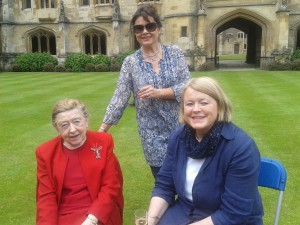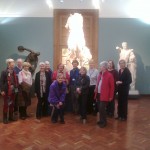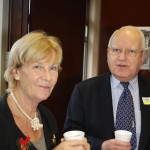Visit to Spitalfields, 31 July 2014
 Around 30 Oxford DFAS members set off on a trip to Spitalfields in East London. The name derives from St Mary’s Priory and Hospital and was settled in the late 17th Century by French Huguenot refugees skilled in silk weaving. We started at Christ Church, one of Nicholas Hawksmoor’s finest churches, which by 1960 had become nearly derelict but which is now restored both inside and out (after a huge fundraising effort) with a sumptuous interior and fine position overlooking the old Spitalfields Market and Wool Exchange. Our well-informed guide, Sue Jackson, then took us to explore the area. The decline in the silk trade had resulted in the attractive Georgian terraces and urban mansions becoming slums occupied by successive waves of immigrants. By the 1960’s a campaign to save the merchant housing was successfully led by Dan Cruikshank, who along with writers and artists such as Jeanette Winterson, Tracey Emin and Gilbert and George, bought houses in the area. Like so much of London, Spitalfields is a place of huge contrasts: 4 million pound homes in some streets, adjacent to large modern office blocks and a large Bangladeshi community, centred on Brick Lane. We ended the day with a visit to 18 Folgate Street. In 1979, Dennis Severs, an American, bought the house and proceeded to turn it into an “experience”. Each of the 10 rooms is depicted in a different historical style from the 18th and 19th Centuries, arranged as though the occupants had just left: unmade beds, half-eaten meals and with the sounds of the time to be heard (church bells, birdsong, running footsteps etc…) Strict silence is requested and the atmosphere is remarkable, if a little confusing at times. It was a really interesting day in a part of London completely unknown to most of us. Many thanks to Josephine for her careful planning and meticulous organisation. RT
Around 30 Oxford DFAS members set off on a trip to Spitalfields in East London. The name derives from St Mary’s Priory and Hospital and was settled in the late 17th Century by French Huguenot refugees skilled in silk weaving. We started at Christ Church, one of Nicholas Hawksmoor’s finest churches, which by 1960 had become nearly derelict but which is now restored both inside and out (after a huge fundraising effort) with a sumptuous interior and fine position overlooking the old Spitalfields Market and Wool Exchange. Our well-informed guide, Sue Jackson, then took us to explore the area. The decline in the silk trade had resulted in the attractive Georgian terraces and urban mansions becoming slums occupied by successive waves of immigrants. By the 1960’s a campaign to save the merchant housing was successfully led by Dan Cruikshank, who along with writers and artists such as Jeanette Winterson, Tracey Emin and Gilbert and George, bought houses in the area. Like so much of London, Spitalfields is a place of huge contrasts: 4 million pound homes in some streets, adjacent to large modern office blocks and a large Bangladeshi community, centred on Brick Lane. We ended the day with a visit to 18 Folgate Street. In 1979, Dennis Severs, an American, bought the house and proceeded to turn it into an “experience”. Each of the 10 rooms is depicted in a different historical style from the 18th and 19th Centuries, arranged as though the occupants had just left: unmade beds, half-eaten meals and with the sounds of the time to be heard (church bells, birdsong, running footsteps etc…) Strict silence is requested and the atmosphere is remarkable, if a little confusing at times. It was a really interesting day in a part of London completely unknown to most of us. Many thanks to Josephine for her careful planning and meticulous organisation. RT
Visit to Yorkshire, 15 to 18 June 2014
Looking back on our brief mid-June sojourn in Yorkshire it seems impossible that we covered so much and with so much enjoyment and no sense of being rushed. Blessed with warm and mostly sunny weather we set off punctually on 15 June and reached the Hepworth Gallery in Wakefield, birthplace of the famous eponymous sculptor, in good time for an interesting guided tour. The imaginatively planned museum is home to a previously unseen collection of her sculptures as well as of Henry Moore’s and works by David Hockney and L S Lowry among other contemporaries. We reached our hotel in Harrogate in time for a drink before supper. Along the way we became aware of plenty of yellow bunting and balloons and even the occasional yellow bike, symptoms of a growing excitement about the forthcoming Tour de France to be staged for the first time in Yorkshire. Next day, after a copious breakfast, we set off on foot for a guided tour of Harrogate which included the Royal Hall and the famous Betty’s tea rooms (where some were able to indulge their passion for chocolates and cream cakes); also the Majestic Hotel where Lord Byron holed up with his mistress, his hounds and his entourage, and finally the beautifully tended Valley Gardens where a bed to celebrate the hundreth year of the founding of the Brownies was being laid out.  One of the highlights of the tour to my mind was the afternoon’s visit to Fountains Abbey, ruins of a Cistercian abbey but with Roman artefacts and several other unparalleled features such as the stunningly beautiful Studley Royal Water Garden dating back to the 18th century plus its mediaeval deer park, its Elizabethan hall and the rather anomalous Victorian church. The evening was happily rounded off with a delightful meal in an Italian restaurant nearby, where one member of the group was able to celebrate her birthday in style. In contrast to the serenity of Fountains Abbey, Tuesday’s visit to Castle Howard, the magnificent 18th century home of the Howard family, where we indulged in a private tour, illustrated the versatility of what there is to see in this part of Yorkshire. The sumptuous house, complete with paintings, Roman antiquities and elegant furnishings, provided plenty to admire, and for those stalwarts seeking the sun, the huge park complete with rose gardens, lakes and fountains offered an enjoyable bonus. York City in the afternoon provided further contrasts. After an amble round the city walls and the Shambles, we visited the hugely impressive York Minster, the largest Gothic cathedral in northern Europe, where we were able to enjoy evensong with well-disciplined choristers adding to the occasion. The evening culminated in our visit to Fairfax House, a stunning Georgian townhouse brimming with treasures, notably some sensational contemporaneous English furniture and portraits, where we indulged in a tasty 3-course private dinner before returning to our hotel replete, minds whirling.
One of the highlights of the tour to my mind was the afternoon’s visit to Fountains Abbey, ruins of a Cistercian abbey but with Roman artefacts and several other unparalleled features such as the stunningly beautiful Studley Royal Water Garden dating back to the 18th century plus its mediaeval deer park, its Elizabethan hall and the rather anomalous Victorian church. The evening was happily rounded off with a delightful meal in an Italian restaurant nearby, where one member of the group was able to celebrate her birthday in style. In contrast to the serenity of Fountains Abbey, Tuesday’s visit to Castle Howard, the magnificent 18th century home of the Howard family, where we indulged in a private tour, illustrated the versatility of what there is to see in this part of Yorkshire. The sumptuous house, complete with paintings, Roman antiquities and elegant furnishings, provided plenty to admire, and for those stalwarts seeking the sun, the huge park complete with rose gardens, lakes and fountains offered an enjoyable bonus. York City in the afternoon provided further contrasts. After an amble round the city walls and the Shambles, we visited the hugely impressive York Minster, the largest Gothic cathedral in northern Europe, where we were able to enjoy evensong with well-disciplined choristers adding to the occasion. The evening culminated in our visit to Fairfax House, a stunning Georgian townhouse brimming with treasures, notably some sensational contemporaneous English furniture and portraits, where we indulged in a tasty 3-course private dinner before returning to our hotel replete, minds whirling.  En route back to Oxford on the Wednesday we fitted in a thrilling visit to Hardwick Hall in Derbyshire. This Elizabethan treasure house dating back to the 16th century is replete with history and offers a rare insight into Elizabethan courtly life as well as illustrating the wealth and changing status of its builder Bess of Hardwick. The rather austere façade is noteworthy for its mountain of glass and the fact that the windows on each ascending storey are larger than those below, unlike most other contemporary and modern houses. Weary but content, we reached Oxford in the early evening after a thoroughly happy and invigorating tour thanks to our indefatigable organisers, Polly and Josephine. SB
En route back to Oxford on the Wednesday we fitted in a thrilling visit to Hardwick Hall in Derbyshire. This Elizabethan treasure house dating back to the 16th century is replete with history and offers a rare insight into Elizabethan courtly life as well as illustrating the wealth and changing status of its builder Bess of Hardwick. The rather austere façade is noteworthy for its mountain of glass and the fact that the windows on each ascending storey are larger than those below, unlike most other contemporary and modern houses. Weary but content, we reached Oxford in the early evening after a thoroughly happy and invigorating tour thanks to our indefatigable organisers, Polly and Josephine. SB
Visit to Pitt Rivers, 25 June 2014
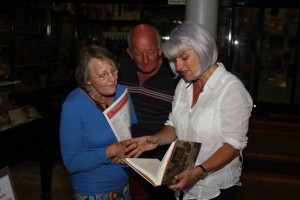 On June 25th, 2014, Oxford DFAS members enjoyed a private evening visit to the Pitt Rivers Museum for a lecture on Tibetan Art given by Professor Claire Harrison. The lecture was followed by a drinks reception and a private view of the Pitt Rivers Museum collection.
On June 25th, 2014, Oxford DFAS members enjoyed a private evening visit to the Pitt Rivers Museum for a lecture on Tibetan Art given by Professor Claire Harrison. The lecture was followed by a drinks reception and a private view of the Pitt Rivers Museum collection.  Professor Harrison’s lecture, with PowerPoint images, was more of a scholarly historic review and assessment of how and why Tibetan Buddhist artefacts found their way to the UK (largely as a result of the 19thC occupying British presence in Tibet and the collection of one man in particular, Younghusband, and how the British public responded to this new religious art form appearing in exhibitions and collections), than the usual art historical lecture that NADFAS members are more familiar with. It was interesting and extremely enlightening to many of us.
Professor Harrison’s lecture, with PowerPoint images, was more of a scholarly historic review and assessment of how and why Tibetan Buddhist artefacts found their way to the UK (largely as a result of the 19thC occupying British presence in Tibet and the collection of one man in particular, Younghusband, and how the British public responded to this new religious art form appearing in exhibitions and collections), than the usual art historical lecture that NADFAS members are more familiar with. It was interesting and extremely enlightening to many of us. 
 Several objects from the Pitt Rivers collection, such as colourful and dramatic eastern puppets made from animal hide, were laid out for members to handle, with a member of staff on hand to help with information about the origins of the pieces. Some Oxford DFAS members were taken to the upper floors of the collection to see pieces donated to the museum by Younghusband himself.
Several objects from the Pitt Rivers collection, such as colourful and dramatic eastern puppets made from animal hide, were laid out for members to handle, with a member of staff on hand to help with information about the origins of the pieces. Some Oxford DFAS members were taken to the upper floors of the collection to see pieces donated to the museum by Younghusband himself.
Get to know .. Oxford Sculptures 13 June, 2014
 Friday 13th June proved a lucky day for those of us who went on the Oxford Sculptures Walk. In glorious sunshine, Kathy Shock, one of our members, took us first to St Edmund Hall to show us a grotesque of Robin Day and then a lovely modern sculpture of St Edmund of Abingdon.
Friday 13th June proved a lucky day for those of us who went on the Oxford Sculptures Walk. In glorious sunshine, Kathy Shock, one of our members, took us first to St Edmund Hall to show us a grotesque of Robin Day and then a lovely modern sculpture of St Edmund of Abingdon.  That set the pattern as Kathy pointed out statues, carvings, grotesques and gargoyles both old and new. It was encouraging to hear that the colleges are still commissioning work and that new faces are replacing old, worn ones. She showed us the carvings on the back of the Bodleian, created from designs by children done in 2009 depicting Aslan the lion, and Tweedledee and Tweedledum. We also saw some on Exeter College spelling out the initials of the college motto Floreat Exon: ‘F’ for flirtatious, ‘L’ for lascivious etc…
That set the pattern as Kathy pointed out statues, carvings, grotesques and gargoyles both old and new. It was encouraging to hear that the colleges are still commissioning work and that new faces are replacing old, worn ones. She showed us the carvings on the back of the Bodleian, created from designs by children done in 2009 depicting Aslan the lion, and Tweedledee and Tweedledum. We also saw some on Exeter College spelling out the initials of the college motto Floreat Exon: ‘F’ for flirtatious, ‘L’ for lascivious etc…  Kathy also gave us more information on the Emperors’ Heads outside the Sheldonian and on the statues around the Quad in Magdalen where we had our drinks party after the last lecture. Oh, there is so much I now want to go and look at again. My husband might be in for a long walk…
Kathy also gave us more information on the Emperors’ Heads outside the Sheldonian and on the statues around the Quad in Magdalen where we had our drinks party after the last lecture. Oh, there is so much I now want to go and look at again. My husband might be in for a long walk…
Summer drinks party, 11 June 2014
The sun shone for our Summer drinks party that we held in The Cloister Quad of Magdalen College following the final sparkling lecture of the season, given by Janet Canetty-Clark on the artistic collaboration between John and and Myfanwy Piper and Benjamin Britten. We’re grateful to Magdalen College for allowing us to use the quad and for providing us with excellent wine, soft drinks and canapés. These photos show how much everyone was enjoying the experience.
Visit to Cirencester and Woodchester Mansion, 13 May 2014
 A splendid day was had by all those who went on the trip to Cirencester and Woodchester Mansion on Tuesday 13th May. The weather smiled on us and the drive took us through beautiful landscape and villages.
A splendid day was had by all those who went on the trip to Cirencester and Woodchester Mansion on Tuesday 13th May. The weather smiled on us and the drive took us through beautiful landscape and villages.  Many of us enjoyed an excellent tour round Cirencester’s magnificent Parish Church of St John the Baptist in the morning, while others opted to visit the New Brewery Arts Centre or the Corinium Museum with its stunning Roman mosaics.
Many of us enjoyed an excellent tour round Cirencester’s magnificent Parish Church of St John the Baptist in the morning, while others opted to visit the New Brewery Arts Centre or the Corinium Museum with its stunning Roman mosaics. 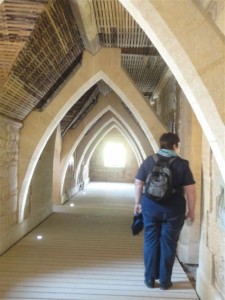 The afternoon was devoted to Woodchester Mansion, an unfinished Victorian Gothic masterpiece approached via a long wooded path flanked by flowering wild garlic. The mansion is fascinating. Abandoned in mid-construction, it offers an extraordinary insight into the building methods used by Mediaeval Gothic workmen as well as such Victorian quirks as a stone bath, the taps concealed in carved stone lion heads – not that water was ever supplied! A chance to watch the antics of the Lesser and Greater Horseshoe bats which live in the building was also on offer through skilfully placed cameras. All in all, it was a great day. Our thanks go to Trish Mather and Kathryn Hopkins who organised it.
The afternoon was devoted to Woodchester Mansion, an unfinished Victorian Gothic masterpiece approached via a long wooded path flanked by flowering wild garlic. The mansion is fascinating. Abandoned in mid-construction, it offers an extraordinary insight into the building methods used by Mediaeval Gothic workmen as well as such Victorian quirks as a stone bath, the taps concealed in carved stone lion heads – not that water was ever supplied! A chance to watch the antics of the Lesser and Greater Horseshoe bats which live in the building was also on offer through skilfully placed cameras. All in all, it was a great day. Our thanks go to Trish Mather and Kathryn Hopkins who organised it.
Get to Know… May 2014
 The May Get to Know… session was on Holywell Cemetery. We met at the Queen’s Lane Coffee House where we congratulated ourselves on the beauty of the day while consuming a cup of coffee. Adrian Williams, one of our members, then led us to Holywell Cemetery. He explained that it had been created in 1847 to serve five parishes. The cemetery contains about 1200 graves. Adrian walked around pointing out the graves of interesting people, some dons but many local families too. The first grave we saw belonged to Kenneth Grahame of ‘Wind in the Willows’ fame. Another famous person buried there is Ken Tynan. Other tombs Adrian showed us included those of Cairns, a brain surgeon who became interested in motorcycle crash helmets after T.E. Lawrence’s fatal accident; Charles Williams, an Inkling; Henry Beaumont Bird, a Magdalen chorister who died aged twelve of typhoid and whose canopied tomb was designed by the man who created the Eleanor Cross. It was pleasing to see a tradesman, Mr Boffin the Baker, and college servants, William Arthur Helliwell and his wife, buried there too.
The May Get to Know… session was on Holywell Cemetery. We met at the Queen’s Lane Coffee House where we congratulated ourselves on the beauty of the day while consuming a cup of coffee. Adrian Williams, one of our members, then led us to Holywell Cemetery. He explained that it had been created in 1847 to serve five parishes. The cemetery contains about 1200 graves. Adrian walked around pointing out the graves of interesting people, some dons but many local families too. The first grave we saw belonged to Kenneth Grahame of ‘Wind in the Willows’ fame. Another famous person buried there is Ken Tynan. Other tombs Adrian showed us included those of Cairns, a brain surgeon who became interested in motorcycle crash helmets after T.E. Lawrence’s fatal accident; Charles Williams, an Inkling; Henry Beaumont Bird, a Magdalen chorister who died aged twelve of typhoid and whose canopied tomb was designed by the man who created the Eleanor Cross. It was pleasing to see a tradesman, Mr Boffin the Baker, and college servants, William Arthur Helliwell and his wife, buried there too. 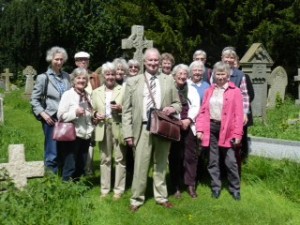 The last burials took place in the 1980s although memorial tablets have been added since then. It is now an actively-managed nature reserve, slightly over-grown but very beautiful and tranquil on a lovely Spring morning. After the talk, several of us had lunch sitting outside St Mary’s and enjoying the view of the Radcliffe camera. All in all, a most enjoyable morning, thanks to Adrian for doing the research and for sharing it with us in such an interesting and engaging manner.
The last burials took place in the 1980s although memorial tablets have been added since then. It is now an actively-managed nature reserve, slightly over-grown but very beautiful and tranquil on a lovely Spring morning. After the talk, several of us had lunch sitting outside St Mary’s and enjoying the view of the Radcliffe camera. All in all, a most enjoyable morning, thanks to Adrian for doing the research and for sharing it with us in such an interesting and engaging manner.
OxDFAS Young Arts Award 2014
The Young Arts committee invited sixth form pupils studying art in the maintained schools and academies in Oxford to enter for this Award. Work in almost any medium was acceptable and there were approximately 30 entrants. The total prize fund of £500 may be spent in any way which will help the winner(s) to develop as an artist; entrants were invited to describe how they would use the funds in a short narrative as part of their entries. A winning selection has been on display at the North Wall Arts Centre. The awards were made to the winners on 7 May at the North Wall. Leah Moorman from the Cherwell School received First Prize, with 4 Highly Commended and 2 Commended. See the Young Arts page for further details.
Get to Know … April 2014
This time the talk was on Pissarro and was again heavily oversubscribed. The places were balloted and the lucky ‘winners’ met for coffee and a chat in the Ashmolean’s roof-top restaurant. Then Diana Cavendish, one of our members, took us to the gallery to learn more about Pissarro. She told us that the museum has the Pissarro family archive giving a wealth of material to explore. Diana told us about Pissarro’s life, his friends, his family and, of course, his paintings. She demonstrated us how the artist’s technique changed and developed by looking closely at works from various periods in his life. She encouraged us to notice Pissarro’s treatment of vegetation and of light. Diana’s vast knowledge left us amazed. She clearly loves the paintings and has enjoyed studying them. This talk fitted in beautifully with the Ashmolean’s current exhibition on Cezanne and the Modern. After the talk, several of us returned to the restaurant for a light lunch. It was a lovely way to get to meet some new people or get to know acquaintances better and to spend a few hours with people who share a common interest. Again, many thanks, Diana.
Get to Know … February 2014
There were lots of people who wanted to go on the second Get to Know… session and those of us who were lucky enough to get places certainly had a treat. After a coffee and a chat in the Vaults Café, Kate Lack, our chairman who also happens to be a Green Badge Guide for Oxford, took us out into Radcliffe Square. There, in the sparkling sunshine, she told us about the history of the Square and some of the magnificent buildings which surround it. She had us all intrigued by a slab of concrete which she revealed marked the boundary between the town and the university. Kate’s talk covered history and facts interspersed with anecdotes and snippets which gave us glimpses into college life. She also brought it right up-to-date by mentioning current and future plans. Kate gave the same blend in The Old Schools Quadrangle and had us all in disbelief as she claimed that Duke Humphrey’s head turns. Once she had revealed the story, our scepticism turned to astonishment! Kate finished her tour by looking at the carvings on Exeter College in Turl Street which spell out the name of the first female rector, Marilyn Butler. A very big ‘thank you’ to Kate from all of us fortunate enough to have been with her.
Get to Know … A new activity, January 2014
In the first very successful session of this new activity, Alison Porter led a tour looking at four statues in the Ashmolean which demonstrate developments in Greek Sculpture in the 6th and 5th centuries BC. The participants enjoyed chatting to each other over coffee and felt it was a good way to meet people.
Visit to the Ashmolean, December 2013
 A group of members were privileged to get a behind the scenes look at the Ashmolean. They were given a tour of the conservation department by head of the department Mark Norman, where they saw amongst other things some restoration work on a wonderful ornately carved picture frame that normally houses a painting of Elias Ashmole. The frame was carved by Grinling Gibbons. The group were also treated to a talk by Jon Whiteley, senior assistant keeper, about JMW Turner’s watercolour sketches.
A group of members were privileged to get a behind the scenes look at the Ashmolean. They were given a tour of the conservation department by head of the department Mark Norman, where they saw amongst other things some restoration work on a wonderful ornately carved picture frame that normally houses a painting of Elias Ashmole. The frame was carved by Grinling Gibbons. The group were also treated to a talk by Jon Whiteley, senior assistant keeper, about JMW Turner’s watercolour sketches.
Christmas Party 2013
70 members and friends of our branch enjoyed the branch’s Christmas drinks party held in Oxford on Wednesday 11th December. Starting with hot coffee and biscuits on arrival to warm up the visitors we then progressed to a sparkling festive drink with an abundance of delicious mince pies. Susan Daniell’s quiz has become a fixture for our Christmas parties and by popular request, she compiled another fiendishly difficult one with sculpture as its theme. It was great fun, helped by the sparkling festive drink, to go round the images in our groups working out who all the sculptors were. The photos below show our progression from hot soft drinks to cold festive drinks. Happy Christmas everyone.
Visit to Laycock Abbey and Corsham Court, 18 September, 2013
OXDFAS, the Oxford branch of NADFAS, organised a very successful visit to two most interesting Wiltshire country properties – Laycock Abbey and Corsham Court with an excellent pub lunch included.  Following a great welcome at the village Church where delicious coffee and excellent biscuits were served, we enjoyed a tour of The Court including some of the private rooms. Corsham Court is a private country home owned by the same family since 1672. The property must hold the record for the most paintings on a single wall. They include Sir Joshua Reynolds, Van Dyck, Dobson and many Italian masterpieces. The furniture and artefacts include china and items from around the world with some superb Chinese pieces. The Bell at Wharf was our lunch stop, where the majority of our 30 strong group enjoyed a very tasty fish platter of crayfish, prawns and delicious smoked salmon.
Following a great welcome at the village Church where delicious coffee and excellent biscuits were served, we enjoyed a tour of The Court including some of the private rooms. Corsham Court is a private country home owned by the same family since 1672. The property must hold the record for the most paintings on a single wall. They include Sir Joshua Reynolds, Van Dyck, Dobson and many Italian masterpieces. The furniture and artefacts include china and items from around the world with some superb Chinese pieces. The Bell at Wharf was our lunch stop, where the majority of our 30 strong group enjoyed a very tasty fish platter of crayfish, prawns and delicious smoked salmon.  Our afternoon visit was Laycock Abbey, founded in 1229 by The Countess of Salisbury which, over the years received partial demolition and the erection of several new extensions that illustrated different period building styles. The house was later owned by the Talbot family and in 1835 William Henry Fox Talbot made the first recorded photographic negative showing the oriel window of the Abbey’s south gallery. We also enjoyed an outstanding exhibition of modern black and white photographs. The picturesque Laycock village, which was left to the National Trust (to avoid death duties) was well worth a tour. TV and feature film period drama fans will recognise many of the street scenes as film sets – there is also an abundance of good tea and homemade cake shops too.
Our afternoon visit was Laycock Abbey, founded in 1229 by The Countess of Salisbury which, over the years received partial demolition and the erection of several new extensions that illustrated different period building styles. The house was later owned by the Talbot family and in 1835 William Henry Fox Talbot made the first recorded photographic negative showing the oriel window of the Abbey’s south gallery. We also enjoyed an outstanding exhibition of modern black and white photographs. The picturesque Laycock village, which was left to the National Trust (to avoid death duties) was well worth a tour. TV and feature film period drama fans will recognise many of the street scenes as film sets – there is also an abundance of good tea and homemade cake shops too.

